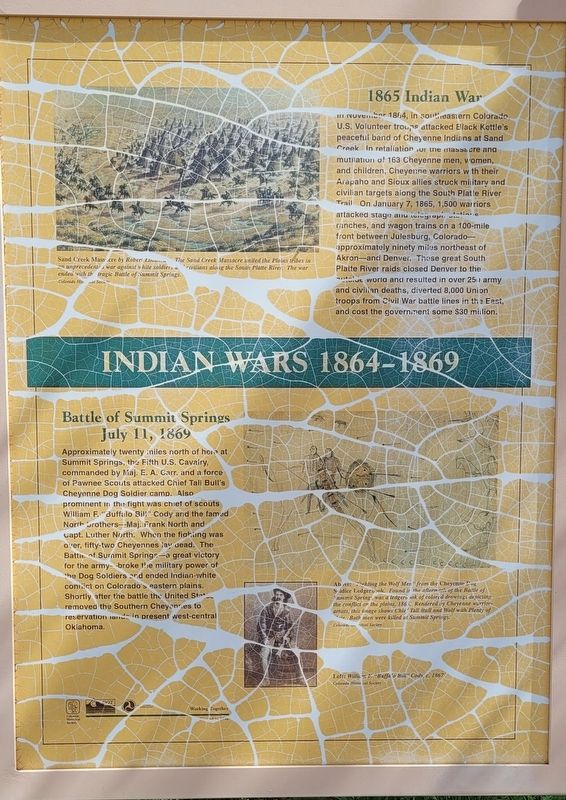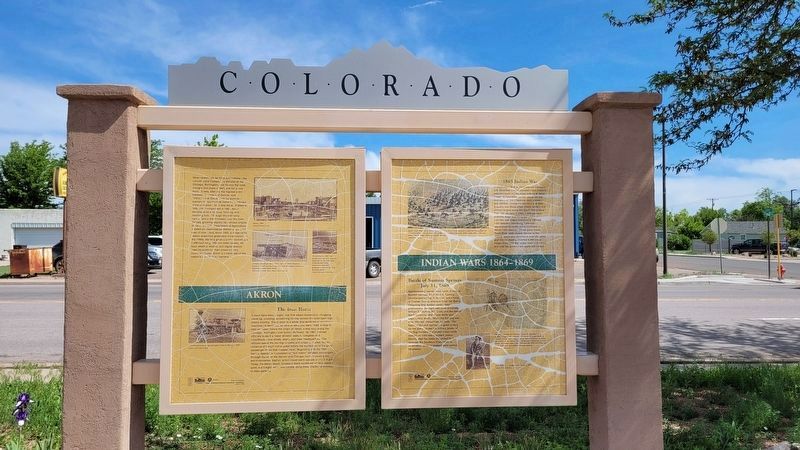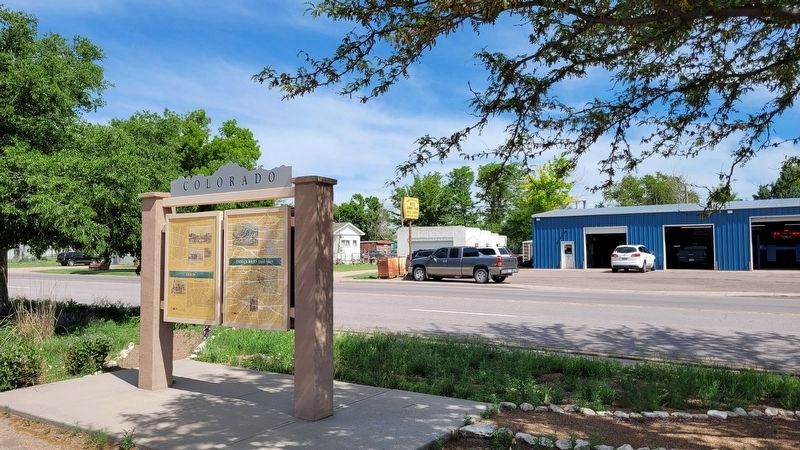Akron in Washington County, Colorado — The American Mountains (Southwest)
Indian Wars 1864-1869
In November 1864, in southeastern Colorado, U.S. Volunteer troops attacked Black Kettle's peaceful band of Cheyenne Indians at Sand Creek. In retaliation for the massacre and mutilation of 163 Cheyenne men, women, and children, Cheyenne warriors with their Arapaho and Sioux allies struck military and civilian targets along the South Platte River Trail. On January 7, 1865, 1,500 warriors attacked stage and telegraph stations, ranches, and wagon trains on a 100-mile front between Julesburg, Colorado - approximately ninety miles northeast of Akron - and Denver. These great South Platte River raids closed Denver to the outside world and resulted in over 250 army and civilian deaths, diverted 8,000 Union troops from Civil War battle lines in the East, and cost the government some $30 million.
July 11, 1869
Approximately twenty miles north of here at Summit Springs, the Fifth U.S. Cavalry, commanded by Maj. E.A. Carr, and a force of Pawnee Scouts attacked Chief Tall Bull's Cheyenne Dog Soldier camp. Also, prominent in the fight was chief of scouts William F. "Buffalo Bill" Cody and the famed North brothers - Maj. Frank North and Capt. Luther North. When the fighting was over, fifty-two Cheyennes lay dead. The Battle of Summit Springs - a great victory for the army - broke the military power of the Dog Soldiers and ended Indian-white conflict on Colorado's eastern plains. Shortly after the battle the United States removed the Southern Cheyennes to reservation lands in present west-central Oklahoma.
Captions
Upper Left: Sand Creek Massacre by Robert Lindneaux. The Sand Creek Massacre united the Plains tribes in an unprecedented war against white soldiers and civilians along the South Platte River. The war ended with the tragic Battle of Summit Springs.
Colorado Historical Society
1st Lower Right: Above: "Fighting the Wolf Men" from the Cheyenne Dog Soldier Ledgerbook. Found in the aftermath of the Battle of Summit Springs was a ledgerbook of colored drawings depicting the conflict on the plains, 1865. Rendered by Cheyenne warrior-artists, this image shows Chief Tall Bull and Wolf with Plenty of Hair. Both men were killed at Summit Springs.
Colorado Historical Society
2nd Lower Right: Left: William F. "Buffalo Bill" Cody, c. 1867
Colorado Historical Society
Erected 1998 by Colorado Historical Society and Colorado Department of Transportation.
Topics. This historical marker is listed in these topic lists: Native Americans • Wars, US Indian. A significant historical date for this entry is January 7, 1865.
Location.
40° 9.538′ N, 103° 13.034′ W. Marker is in Akron, Colorado, in Washington County. Marker is at the intersection of West 1st Street (U.S. 34) and Custer Avenue, on the left when traveling west on West 1st Street. Located at a small city park along the highway. Touch for map. Marker is at or near this postal address: 425 W 1st St, Akron CO 80720, United States of America. Touch for directions.
Other nearby markers. At least 2 other markers are within walking distance of this marker. Akron (here, next to this marker); Last Days of the Buffalo / Akron Country (here, next to this marker).
Also see . . .
1. Sand Creek massacre.
The Sand Creek massacre (also known as the Chivington massacre, the battle of Sand Creek or the massacre of Cheyenne Indians) was a massacre of Cheyenne and Arapaho people by the U.S. Army in the American Indian Wars that occurred on November 29, 1864, when a 675-man force of the Third Colorado Cavalry under the command of U.S. Volunteers Colonel John Chivington attacked and destroyed a village of Cheyenne and Arapaho people in southeastern Colorado Territory, killing and mutilating an estimated 69 to over 600 Native American people. Source: Wikipedia(Submitted on June 14, 2022, by James Hulse of Medina, Texas.)
2. Battle of Summit Springs.
The Battle of Summit Springs, on July 11, 1869, was an armed conflict between elements of the United States Army under the command of Colonel Eugene A. Carr and a group of Cheyenne Dog Soldiers led by Tall Bull, who was killed during the engagement. The US forces were assigned to retaliate for a series of raids in north-central Kansas by Chief Tall Bull's Dog Soldiers band of the Cheyenne. Source: Wikipedia(Submitted on June 14, 2022, by James Hulse of Medina, Texas.)
Credits. This page was last revised on March 4, 2024. It was originally submitted on June 14, 2022, by James Hulse of Medina, Texas. This page has been viewed 509 times since then and 8 times this year. Photos: 1, 2, 3. submitted on June 15, 2022, by James Hulse of Medina, Texas.


